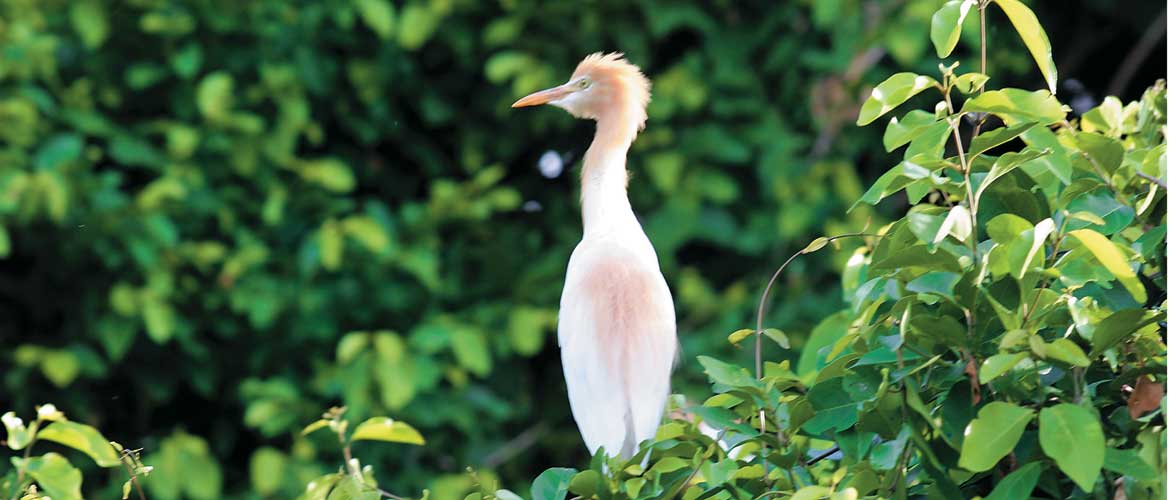Usually, getting to bird sanctuaries in Tamil Nadu involves a lot of teeth-rattling road time,
As we enter the Vedanthangal Sanctuary, through a gate guarded by monkeys, no less, there is the thrum of satisfied birds eating, swimming, diving, homemaking and squawking. They seem to be happy doing nothing, enjoying their last few days of rest before starting on the long flights home. They are accustomed to visitors, and some of the birds venture quite close to the tourists. Beyond the islands full of mangroves, they perch on the trees that line the banks and reach out to the water.
The Barringtonia mangroves of the sanctuary create a floating habitat for a variety of migratory birds. We walk along a shaded stone pathway around the mangroves to view the birds on our left. On the other side are extensive chartreuse paddy fields and a gorgeous sunset – luckily, we are visiting at the right time. The setting is so beautiful that I feel the sanctuary extends beyond its watery boundaries. We try to guess the number of birds by counting how many there are in the trees. It proves to be a futile exercise, as the mangroves extend far into the distance and the horizon seems to rustle with white wings. Official reports claim there are between 10,000 to 20,000 birds per season, resting, sheltering and breeding on what are apparently 2,000 partially-submerged trees.
We climb one of the watchtowers and immediately spot a trio of painted storks gathering twigs from a tree to build their nests. Their delicate balancing act on the thinnest of branches reminds me of the gravity-defying scenes in a martial arts flick, where a dexterous fight takes place atop bamboo reeds. The painted storks are by far the most expressive species in the sanctuary, with milky wings that rise to fuschia at the tips. There is also considerable pleasure in watching birds that are merely resting. We notice many villagers in the sanctuary; they wield a lot of influence in the running of the sanctuary.

The village and reserve’s boundaries meld together, and in fact, the 73-acre sanctuary and its surroundings were only deemed a protected zone after the villagers complained about the intemperate hunting of the birds by the British. At dusk, you can watch young goat-herds returning home with their flocks or the brightly painted oxen preparing to doze off – all an integral part of the typical evening scene in villages.
The pace of life suddenly seems slower, and coupled with the pacifying landscape and the harmonious coexistence of humans and nature, life’s harsher realities seem far away – if only for the time you actually spend in the park. Vedanthangal is close to the temple towns of Mahabalipuram and Kanchipuram and one can visit the sanctuary on the return journey from these towns.
ABOUT VEDANTHANGAL SANCTUARY
Said to be the oldest water sanctuary in India, the Vedanthangal Bird Sanctuary was granted legal protection in 1798. Spread over 30 hectares, the ecosystem here is made up of islands of Barringtonia mangroves, evergreen scrub and thorn forest. The area was recognised as a sanctuary in 1936. The 1962 Madras Forest Act accorded it the status of a reserve forest and, subsequently, the 1972 Wildlife Protection Act pronounced it a wildlife sanctuary.
ORIENTATION
You can take NH45 from Chennai to the nearest township, Chengalpattu. From here, continue to the Padalam Junction (Padalam town is 12km from the sanctuary). Turning right from here, drive for about 20 minutes and you’ll pass the forest rest house (FRH); drive on for another kilometre to reach the sanctuary gate, the adjoining ticket booth and the car park.
There is an interpretation centre (in a state of disrepair, but of some interest), where a knowledgeable ticket collector will also act as your guide. Guides can be hired at the sanctuary as well.
The birds can be viewed from the clear, stone paved path that follows the western embankment of the lake. Most of the facilities seem to have been designed with the tourist in mind and are very well-maintained.
There are granite benches along the way for you to rest and various watchtowers (with winding staircases) that offer good views of the sanctuary, though I don’t think the binoculars affixed to the towers were working when we were there.
Tip You might want to plan a weekday tour, as it gets very crowded on weekends
◆ Entry ₹5 per person Timings 6.00am–6.00pm Camera ₹25 Parking ₹50 Contact Range office
THINGS TO SEE AND DO
If you care passionate about bird-watching, you can spend long hours just looking at the birds here go about their daily routine and not get bored at all.
Children, in particular, will find a visit to this bird sanctuary an engrossing one. You can also spot mammals such as jackal, jungle cat, wild boar and black-naped hare.
Birdwatching

Follow the paved path, dotted with watchtowers and benches, to survey the birds nesting in the tank area and their counterparts in the surrounding fields and scrub. Amongst the different bird species here, look for white ibis, Asian spoonbill, grey heron, grey pelican, rosy pelican, night heron and cormorant. Both in the sanctuary and outside (especially in the surrounding fields and grasslands), you will spot the Eurasian thick-knee, black-headed cuckoo shrike and yellow-wattled lapwing, apart from several other Indian species. Take binoculars, a bird book and a zoom lens camera, all of which will make your visit to the wildlife sanctuary memorable.
WHERE TO STAY AND EAT
The Forest Rest House (Tariff: ₹770), which is 1km from the sanctuary gate, has four clean, well-maintained AC rooms. Meals are available on request. Reservations can be done through the Wildlife Warden’s office in Chennai or Range Officer, Vedanthangal Bird Sanctuary. There is a cluster of tea shops outside the main gate where you can have refreshments. You will also find vendors selling guavas, tender coconuts and watermelons.
AROUND VEDANTHANGAL
Karikili Bird Sanctuary (9km)
This reserve, located on the Uttaramerur Road, is another great retreat for birdwatchers. Pintailed ducks, Garganey teals and common teals are found in abundance here. You should plan to spend at least a night at Vedanthangal so that you can get to Karikili early to enjoy the wonderful morning scenery.
◆ Contact 044-24321471
GETTING THERE
State Tamil Nadu
Location Off NH45 from the state capital Chennai, close to the small town of Padalam in Kanchipuram District
Distance 86km SW of Chennai
Route from Chennai NH45 to Padalam Junction via Chengalpattu; district road to Vedanthangal Bird Sanctuary
Road Take NH45 from Chennai (86km/ 1.5hrs) to the nearest big town Chengalpattu (35km), and continue south to Padalam Junction. (Padalam is a small town in the opposite direction from the sanctuary.) Turn right here to access the sanctuary road. Vedanthangal can also be approached from Kanchipuram and Mahabalipuram but the roads are in poor condition.
Bus Several buses ply from Chennai to Chengalpattu; onward connections to the sanctuary are available, but the best option is to hire a taxi from Chennai (₹10–14 per km)
FAST FACTS
When to go The best season to visit is November–March. Breeding season lasts from October/ November to March, peaking in December–January when about 30,000 birds nest here
Go there for Painted storks, oriental darters and ibis
Wildlife/ Forest Dept offices
Forest Department
Chennai. Tel: 044-22351471
Range OfficerVedanthangal
Tel: 22200335
STD code 044
Chengalpattu
Vedanthangal Bird Sanctuary
Birding





